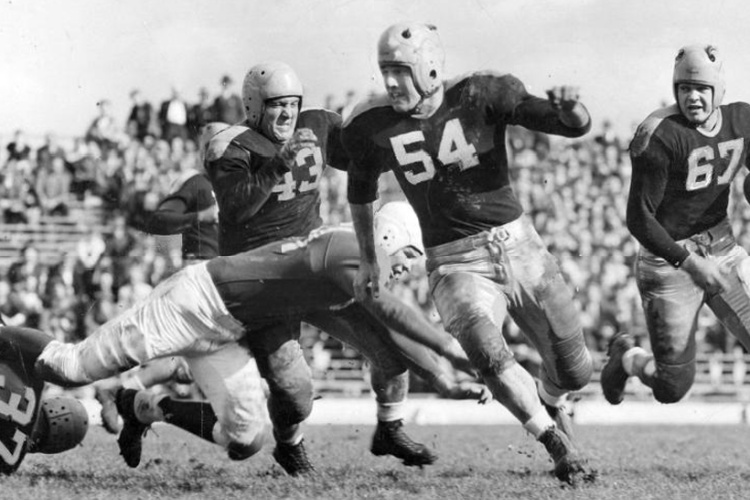The Humble Beginnings Of The NFL
For many decades, the National Football League (NFL) has been known for glitz and big money as much as it’s been renowned for the delivery of high-level athleticism. But that wasn’t always the case; in fact, the NFL had a rather humble start that generated only a modicum of excitement at the time.
Here’s a look back at the National Football League’s origins, and how a quiet beginning led to the making of many a football legend.

The Kickoff
On September 17, 1920, 14 men gathered at Jordan and Hupmobile automobile showroom in downtown Canton, Ohio, with the sole aim of striking a deal. Ralph Hay’s dealership was about to become the setting for the creation of a professional football league, the likes of which had never been seen before.
By 1920, pro football was being overshadowed by the college game and was bleeding money at the same time, owing to player bidding wars and high salaries. Hay, the owner of the reigning Ohio League champion Canton Bulldogs, invited representatives from three other in-state teams to discuss the development of a new football association. According to the Canton Evening Repository, they proposed a new venture that would “…raise the standard of professional football in every way possible, to eliminate bidding for players between rival clubs and to secure cooperation in the formation of schedules.”
Several weeks after the initial meeting, Hay met with representatives from 11 professional football clubs: Racine Cardinals, Akron Pros, Cleveland Indians, Canton Bulldogs, Decatur Staleys, Dayton Triangles, Massillon Tigers, Muncie Flyers, Rochester Jeffersons, Hammond Pros, and Rock Island Independents. The football visionaries, including George Halas and Jim Thorpe, sat on the running boards and fenders of cars on the showroom floor while they hammered out an initial agreement.

Huddling Together
The group of football representatives that Hay had called together developed a proposal to form the American Professional Football Association (APFA). The newly formed league needed a president who could serve as its public face, and Thorpe was unanimously chosen. The selection of the gridiron’s greatest gate attraction at that time garnered more national publicity than the formation of the APFA itself.
The first APFA game took place on September 26, 1920, at Douglas Park in Rock Island, Illinois; the hometown Independents bested the St. Paul Ideals 48-0. One week later, the first head-to-head battles in the league took place, with Dayton topping Columbus 14-0 and Rock Island beating Muncie 45-0.
Although the gridiron dimensions in place at the time were much the same as current guidelines, the pro game itself varied significantly compared to how the game is played today. For example, coaching from the sidelines was prohibited, players competed on both defense and offense, and forward passes were rare. As opposed to today’s standard 16-game schedule, football clubs in 1920 planned who they would play and how often, and they could play college squads or nonleague clubs in games that would count toward their records. Needless to say, official standings were absent.
Even with the addition to the league of the Chicago Tigers, Buffalo All-Americans, Detroit Heralds, and Columbus Panhandles, the APFA inaugural season was a struggle. Games received little press attention and didn’t garner a great deal of fan adulation. According to Robert W. Peterson’s book Pigskin: The Early Years of Pro Football, APFA games averaged crowds of 4,241.

End Game
The end of the first APFA season came and went with little fanfare: no playoffs, no Super Bowl, and a league champion that wasn’t even crowned until four months later. The APFA determined its victor by ballot, and on April 30, 1921, team representatives voted the Akron Pros, who completed the season undefeated with eight wins and three ties, despite protests by the one-loss teams in Buffalo and Decatur, each of whom had tied Akron and boasted more wins.
To the victor goes the spoils, and the APFA champions received a silver-loving cup donated by sporting goods company Brunswick-Balke-Collender. Players received golden football-shaped fobs inscribed with “World Champions.”
Deciding that they were in need of a leader who possessed greater business acumen, team owners replaced Thorpe with Columbus Panhandles owner Joe Carr, and in 1922 the APFA rebranded itself as the National Football League (NFL). To the owners’ dismay, the NFL failed to ignite much excitement, and college football retained its allure as the big draw: Crowds as large as 100,000 were not unheard of at college games. The NFL’s first season was quickly forgotten and rendered unimportant; until the 1970s, the league’s official record books listed the 1920 championship as undecided. But with the signing of college phenom Red Grange in 1925, pro football began to increase in popularity and gain the attention of fans and the media.
What happened to the Brunswick-Balke-Collender Cup awarded to the first championship team? No one knows. The legacy of two APFA franchises, however, continues: The Decatur Staleys moved to Chicago in 1921 and the following year changed their name to the Bears, and the Racine Cardinals now play in Arizona. The 10 APFA players, along with Carr, are enshrined in the Pro Football Hall of Fame, which was established in 1963 in a location not far from the Canton automobile dealership that gave birth to the start of the NFL in 1920.

